The German Shorthaired Pointer is a magnificent breed of dog that has captured the hearts of many animal lovers worldwide. This versatile canine is fascinating with its rich history, unique characteristics, and impressive abilities. In this blog post, we will delve into the world of the German Shorthaired Pointer, exploring its background, exciting facts, size, habitat, and classification.
Originating in Germany in the 19th century, the German Shorthaired Pointer was bred as a versatile hunting dog. Its ancestors can be traced back to various breeds, including the Spanish Pointer, Foxhound, and Bloodhound, resulting in a multi-talented companion. Renowned for its exceptional hunting skills and intelligence, this breed quickly gained popularity among hunters, making them valued assets in the field.
Regarding physical appearance, German Shorthaired Pointers are medium to large-sized dogs, typically weighing 45 to 70 pounds and standing about 21 to 25 inches tall at the shoulder. Their short, dense coat comes in various colours, including liver, black, or a combination of both with white markings. This breed’s unique coat allows it to adapt to various weather conditions, making it well-suited for hunting in different terrains.
History of German Shorthaired Pointer

The German Shorthaired Pointer is a breed of dog that originated in Germany. Its history dates back to the 19th century when hunters in Germany needed a versatile and all-purpose hunting dog. They wanted a dog to point, retrieve, and track games on land and water.
Breeders crossed various hunting dogs, such as Spanish Pointers, Bloodhounds, and Foxhounds. The result was a breed with the speed, agility, and endurance to chase game, the keen sense of smell to locate it, and the intelligence and trainability to work closely with their human companions.
The German Shorthaired Pointer quickly gained popularity among hunters for its exceptional hunting skills and versatility. It became known as an excellent bird hunter, capable of pointing at the game, retrieving it, and tracking wounded animals. This breed became a favourite of both professional hunters and sportsmen.
Over time, the German Shorthaired Pointer also found success outside hunting circles. Its friendly and sociable nature made it a beloved family pet and a popular choice in dog sports such as obedience, agility, and tracking competitions. Today, the German Shorthaired Pointer is recognized as a versatile working dog and a loyal companion, valued for its intelligence, athleticism, and affectionate nature.
Importance of German Shorthaired Pointer

The German Shorthaired Pointer (GSP) is vital for many reasons. First and foremost, they are excellent hunting companions. With their strong sense of smell, speed, and agility, GSPs can help hunters find and retrieve game-like birds and rabbits. This makes them an excellent asset for hunters who rely on their skills to put food on the table.
Another reason why GSPs are essential is their loyalty and devotion to their families. They are known to be very affectionate and protective, making them excellent family pets. They are also great with children, making them an excellent addition to any household. GSPs are intelligent and can be easily trained, which adds to their value as family pets.
Lastly, GSPs make excellent search and rescue dogs. Their athleticism and ability to track scents make them highly effective in finding missing persons or lost hikers in rugged terrain. Their determination and endurance allow them to cover large areas and locate people needing help. This makes GSPs a valuable asset to search and rescue teams, helping to save lives.
German Shorthaired Pointers are essential animals for hunting, being loyal family pets, and assisting in search and rescue operations. Their unique skills and traits make them versatile and valuable companions in various aspects of life.
Amazing Facts About German Shorthaired Pointer

1. The German Shorthaired Pointer is a breed of dog that originated in Germany.
2. They are medium to large dogs with muscular and athletic build.
3. These dogs have a short and dense coat, usually liver or liver white.
4. German Shorthaired Pointers have an average lifespan of about 12-14 years.
5. They are known to be intelligent and highly trainable dogs.
6. These friendly and outgoing dogs make them great family pets.
7. German Shorthaired Pointers are excellent hunting dogs and can track and retrieve game on land or in water.
8. They have a strong sense of smell and excel in tasks such as search and rescue or drug detection.
9. These dogs require regular exercise and mental stimulation to stay happy and healthy.
10. German Shorthaired Pointers are generally good with children and other pets if socialized properly from a young age.
11. They have a strong prey drive, so keeping them on a leash or in a secure fenced area when outside is essential.
12. Grooming needs for this breed are minimal, with occasional brushing to keep their coat clean and tidy.
13. Regular health check-ups and vaccinations are essential to ensure the well-being of German Shorthaired Pointers.
14. Responsible breeding is essential because They are prone to specific genetic health issues, such as hip dysplasia and certain eye disorders.
15. German Shorthaired Pointers are loyal and affectionate companions who thrive in an active and loving home environment.
Can we keep a German Shorthaired Pointer as our Pet?
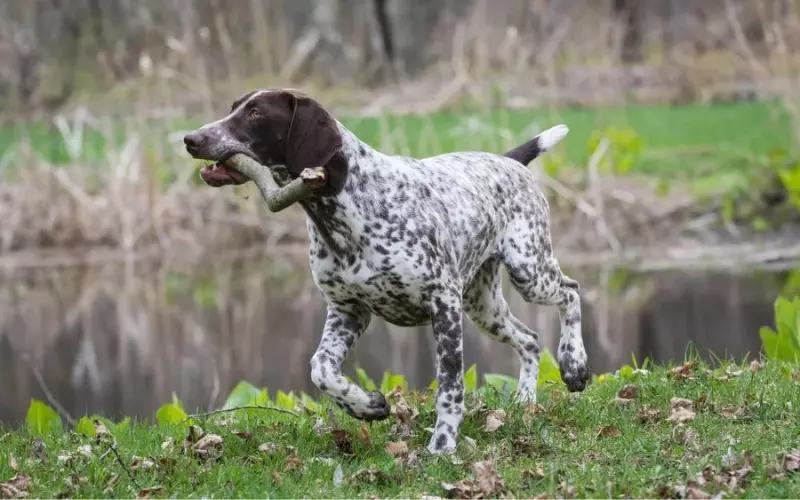
The German Shorthaired Pointer is a beautiful animal, but unfortunately, it cannot be kept as a pet. This dog breed is known for its intelligence, agility, and friendly nature. They are great companions for active people who enjoy outdoor activities like running or hiking. However, due to their specific needs and genetic characteristics, it is essential to note that this animal cannot be owned as a pet.
The German Shorthaired Pointer is not extinct but is an endangered breed. It means that their population is decreasing, and they are at risk of disappearing. This is because they require special care and attention, and not everyone can meet their needs. They need plenty of exercise, mental stimulation, and a dedicated owner who can give them the time and attention they deserve.
Moreover, the breed has specific health issues and may require frequent visits to the veterinarian. The German Shorthaired Pointer also tends to have a strong hunting instinct, which can make it challenging to keep them as pets in specific environments. It is crucial to remember that when animals become extinct or endangered, we are responsible for supporting their conservation efforts and respecting their natural habitat.
While the German Shorthaired Pointer is a remarkable animal, it is not suitable to be kept as a pet due to its specific needs and decreasing population. It is vital to understand that the welfare and conservation of animals should always be a priority.
Size of German Shorthaired Pointer
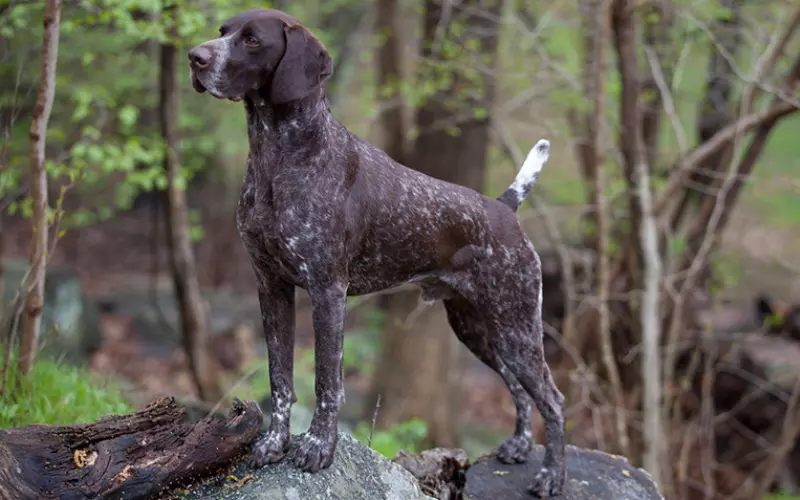
German Shorthaired Pointers are medium-sized dogs known for their muscular build and athletic bodies. On average, they stand between 21 to 25 inches tall at the shoulder. This means they are about the same size as a large suitcase or regular backpack. These dogs have a balanced body structure with a muscular build, which helps them excel in various activities such as hunting, tracking, and competitive sports.
The German Shorthaired Pointer is usually between 45 and 70 pounds, which is similar to the weight of an average 10-year-old child. Due to their muscular physique, they have the stamina to remain active and energetic throughout the day. However, maintaining a healthy weight is crucial for these dogs to avoid strain on their joints and overall health.
Despite their size, German Shorthaired Pointers are well-regarded for their agility and speed. They have a swift and graceful gait, allowing them to cover much ground quickly. Additionally, their keen sense of smell and eyesight further aid their hunting or tracking activities. These dogs are versatile and adaptive, making them suitable for various lifestyles and living environments as long as they receive enough exercise and mental stimulation.
German Shorthaired Pointers are medium-sized dogs with a solid and athletic build. They typically measure between 21 to 25 inches at the shoulder, and their weight ranges from 45 to 70 pounds. These dogs are known for their agility, speed, and adaptability, which makes them an excellent choice for active individuals or families who can provide them with the necessary exercise and mental stimulation.
Habitat of German Shorthaired Pointer
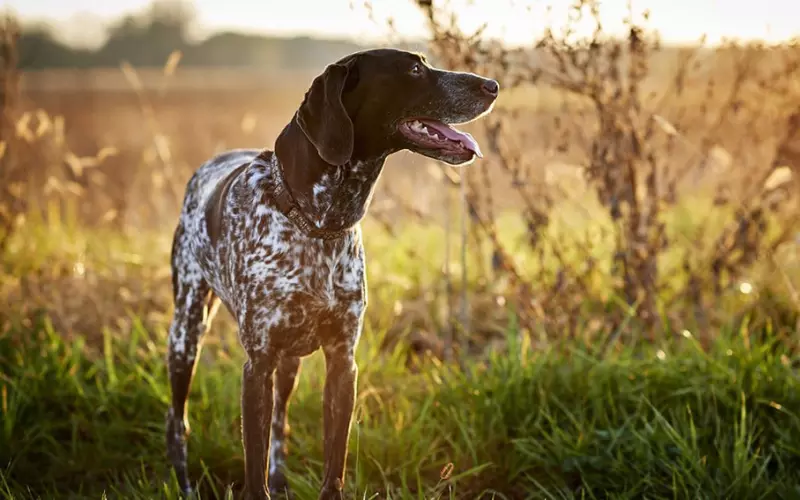
The German Shorthaired Pointer is a versatile, energetic dog breed that thrives in various habitats. These dogs are highly adaptable and can be found in urban and rural environments. However, they are most content in homes with large, fenced-in yards with plenty of space to run and play.
Regarding climate, the German Shorthaired Pointer can adapt to different temperatures. They have a short coat that helps regulate their body temperature, making them comfortable in warm and cold climates. However, they are not well-suited for extreme heat, so it is essential to provide them with shade and plenty of water during hot weather.
The German Shorthaired Pointer is a hunting breed, so they love being in nature and exploring their surroundings. They thrive in habitats with plenty of open space, fields, forests, and parks. These active animals require daily exercise and mental stimulation to be happy and healthy, so having access to outdoor areas where they can engage in activities like running, fetching, and sniffing is essential.
The German Shorthaired Pointer is a highly adaptable dog that can live in various habitats. They are most comfortable in homes with large yards but can also thrive in urban environments as long as they receive enough exercise and mental stimulation. These energetic dogs love being in nature and require plenty of space to explore and play. So, if you’re considering getting a German Shorthaired Pointer, ensure you have the right habitat to provide them with a happy and fulfilling life.
Evolution of the German Shorthaired Pointer
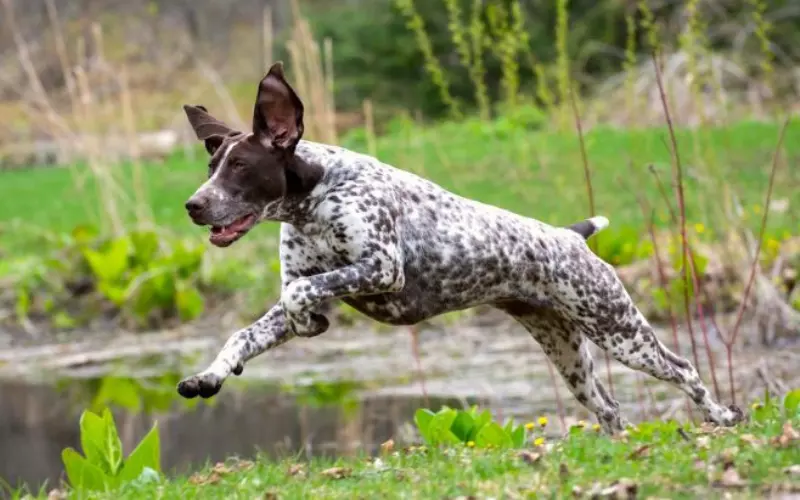
The German Shorthaired Pointer, a dog breed known for its hunting abilities and friendly nature, has a long and exciting history. This breed’s evolution can be traced back to several dog breeds brought to Germany from different parts of the world. Over time, these dogs were carefully selected and bred to create the German Shorthaired Pointer we know today.
The first stage of the evolution of this breed began in the 17th century when Spanish Pointers were imported to Germany. These dogs were known for their excellent hunting skills, and they were crossed with local German scent hounds. This mix produced a versatile dog with a keen sense of smell and the ability to point and retrieve.
In the 19th century, further advancements in the breed’s development occurred by introducing English Pointers and some other breeds, like the Foxhound and the German Bird Dog. Through selective breeding, desired traits such as endurance, speed, and a natural ability to track scent were enhanced. This process continued for several decades, resulting in the German Shorthaired Pointer we see today.
Overall, the evolution of the German Shorthaired Pointer involved a deliberate breeding program to create a versatile and skilled hunting dog. The breed’s ancestors, from different parts of Europe, contributed their unique traits, which were selectively combined through generations of careful breeding. As a result, the German Shorthaired Pointer now stands as an intelligent and athletic breed, suitable for various tasks like hunting, tracking, and even being a loving family companion.
Classification of German Shorthaired Pointer

The German Shorthaired Pointer is a type of dog that belongs to the sporting group of animals. It is known for its strong hunting skills and ability to work in various environments. These dogs are medium-sized, with a lean and muscular body. The breed’s short and dense coat is usually in liver or liver and white colours.
Regarding temperament, German Shorthaired Pointers are known to be intelligent, obedient, and friendly. They are eager to please their owners and are often used for hunting, tracking, and obedience trials. These dogs are also known for their high energy levels and need for regular exercise.
The German Shorthaired Pointer is often classified as a versatile hunting breed. They have a strong sense of smell and excellent endurance, making them suitable for different hunting activities. They are often used to locate and retrieve game on land and water. This breed also excels in other dog sports like agility and field trials.
The German Shorthaired Pointer is a medium-sized dog belonging to the sporting group. They have a lean and muscular body and a short, dense coat. These dogs have a friendly and obedient temperament and excel in various hunting activities and dog sports. If you are considering getting a German Shorthaired Pointer as a pet, ensure you are ready to provide them with the exercise and mental stimulation they need to thrive.
How did the German Shorthaired Pointer Extinct?
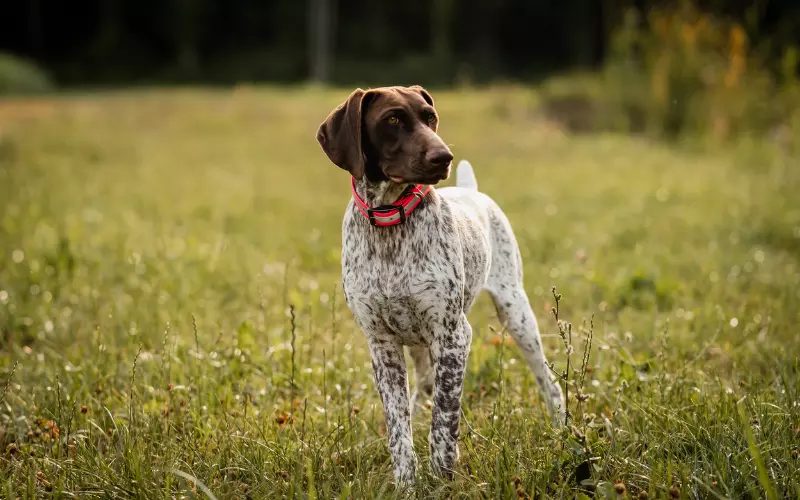
1. The German Shorthaired Pointer, or GSP, is a versatile and athletic breed primarily used for hunting.
2. They are known for their exceptional speed and endurance, allowing them to cover long distances while retrieving the game.
3. GSPs have a distinctive coat, which is short and dense, making it easy to maintain and keeping them comfortable in various weather conditions.
4. These dogs are brilliant and trainable, making them suitable for various activities such as obedience, agility, and search and rescue operations.
5. GSPs are known to be great family pets as they are loyal, friendly, and affectionate towards their owners and can form strong bonds.
6. Due to their natural hunting instincts, they may not be suitable for households with smaller pets such as cats, rabbits, or birds.
7. As with any dog breed, regular exercise is essential for GSPs to keep them physically and mentally stimulated, preventing boredom and destructive behaviour.
8. GSPs are generally healthy dogs, but like many large breeds, they may be prone to specific health issues such as hip dysplasia, elbow dysplasia, or even bloat. Regular vet check-ups are necessary to ensure their well-being.
9. Socialization from an early age is crucial for GSPs to ensure they become well-rounded dogs, comfortable in various social settings.
10. The German Shorthaired Pointer is a prevalent breed owing to its versatility, intelligence, and loyalty. However, potential owners should consider their energy levels and exercise requirements to ensure they can provide an active and stimulating environment for these incredible dogs.
Geographical Presence of German Shorthaired Pointer
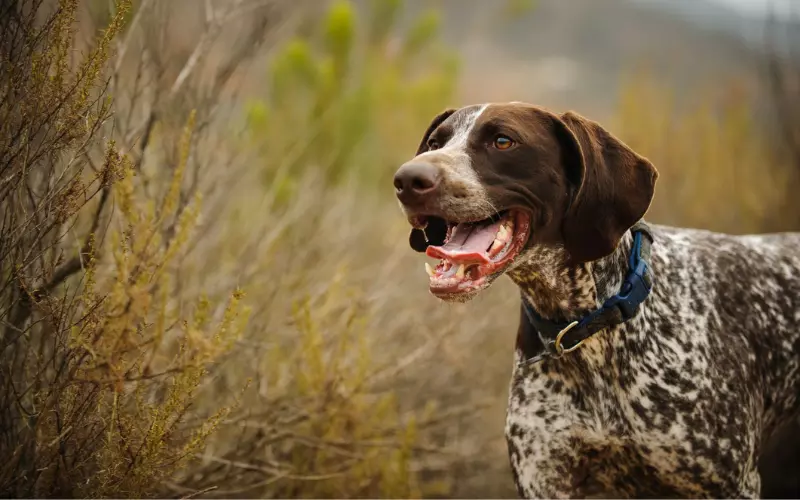
The German Shorthaired Pointer is an animal found in various regions worldwide. These dogs are native to Germany, as you can tell from their name. They were initially bred for hunting and have become popular as family pets. German Shorthaired Pointers have a strong hunting instinct, excellent scenting abilities, and are very active and energetic.
However, German Shorthaired Pointers are not found in every part of the world. They are more commonly found in regions where the climate suits their needs. These dogs thrive in temperate climates and prefer regions with moderate temperatures and rainfall. They may not be suited for extremely hot or cold climates. Therefore, you would not typically find German Shorthaired Pointers in deserts or the Arctic regions.
The German Shorthaired Pointer is a beautiful and versatile breed in various regions worldwide. They are hunters at heart but also make loyal and loving companions. Just remember that they are more common in temperate regions and may not be found in areas with extreme climates. So, if you ever encounter one of these beautiful dogs, consider yourself lucky to have encountered a German Shorthaired Pointer!
Scientific Name of German Shorthaired Pointer

The scientific name of the German Shorthaired Pointer is Canis lupus familiaris. Canis lupus familiaris is the scientific name for domestic dogs, and it refers to the subspecies of the grey wolf bred explicitly by humans for specific characteristics.
German Shorthaired Pointers are a specific breed of domestic dog known for their versatile hunting abilities. They have a distinct short coat that helps them stay agile and comfortable during physical activities. These dogs are highly energetic and require regular exercise to stay happy and healthy.
German Shorthaired Pointers are known for their keen sense of smell, which makes them excellent hunting companions. They are often used for various hunting tasks, such as tracking and retrieving the game once it has been shot down. These dogs are also quite intelligent and can be trained easily. With proper training and socialization, they make loyal and loving family pets.
The scientific name for the German Shorthaired Pointer is Canis lupus familiaris. These dogs are highly skilled hunters and make great companions. Their short coat, intelligence, and energetic nature set them apart from other breeds.
Diet of German Shorthaired Pointer

The diet of a German Shorthaired Pointer is an essential aspect of keeping them healthy and strong. They need a balanced diet that provides all the necessary nutrients for their body. It is best to feed them high-quality dog food specially formulated for active breeds like them. This food should have a good balance of proteins, carbohydrates, fats, vitamins, and minerals.
Proteins are essential for German Shorthaired Pointers as they help build and repair their muscles. Chicken, turkey, beef, and fish are good protein sources for them. Carbohydrates provide energy and can be found in rice, oats, and potatoes. Fats are also crucial for their overall health and can be obtained from fish or flaxseed.
In addition to their regular meals, German Shorthaired Pointers also need treats. These treats should be given in moderation and not make up a large part of their diet. Choosing healthy treats that are low in fat and sugar is essential. Some good options include small pieces of fruit or vegetables.
Finally, it is essential to provide plenty of fresh, clean water for the German Shorthaired Pointer to stay hydrated throughout the day. Water is vital for their digestion, temperature control, and overall well-being.
To summarise, a German Shorthaired Pointer needs a balanced diet that includes high-quality dog food, proteins, carbohydrates, and fats. Treats should be given in moderation, and fresh water should always be available. By providing the proper diet, we can help these beautiful dogs stay healthy and happy.
Locomotion of German Shorthaired Pointer

The German Shorthaired Pointer is an intelligent and active dog breed. They have a solid and agile body that allows them to move quickly and gracefully. When they move, they use a type of locomotion called running.
When a German Shorthaired Pointer runs, it uses all four legs to push off the ground. Their back legs give them the power to propel forward, while their front legs help them maintain balance. This allows them to run smoothly and efficiently. Their long, lean body helps them move swiftly, making them excellent runners.
Overall, the German Shorthaired Pointer has a beautiful and effortless way of moving when they run. Their solid and agile bodies allow them to run with speed and grace, making them a joy to watch.
Social and Sexual Behaviour of German Shorthaired Pointer
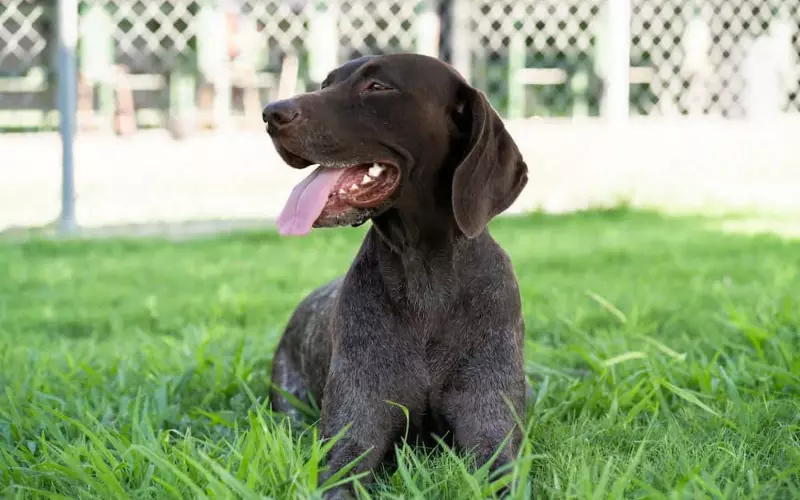
The Social and Sexual Behaviour of the German Shorthaired Pointer is quite interesting. These animals are known to be very friendly and affectionate towards their families. They enjoy being around people and are often called “velcro dogs” because they like staying close to their owners. They can also get along well with other dogs if they are properly socialized from a young age.
German Shorthaired Pointers are pretty social and love to be included in family activities. They are often seen as part of the family rather than just a pet. They enjoy playing and interacting with their human companions and thrive on attention and praise. This breed is known to be eager to please and will often try their best to make their owners happy.
When it comes to their sexual behaviour, German Shorthaired Pointers can be pretty active. They reach sexual maturity around the age of six to nine months. They may display mating behaviours during this time, such as mounting other dogs or objects. Their owners must have them spayed or neutered to prevent unwanted litters and control their reproduction.
The German Shorthaired Pointer is a social and affectionate breed. They enjoy being around people, love to play, and aim to please their owners. When it comes to sexual behaviour, they must be spayed or neutered to prevent unexpected puppies. Taking good care of these dogs ensures they can lead healthy and happy lives.
Reproduction and Lifecycle of German Shorthaired Pointer
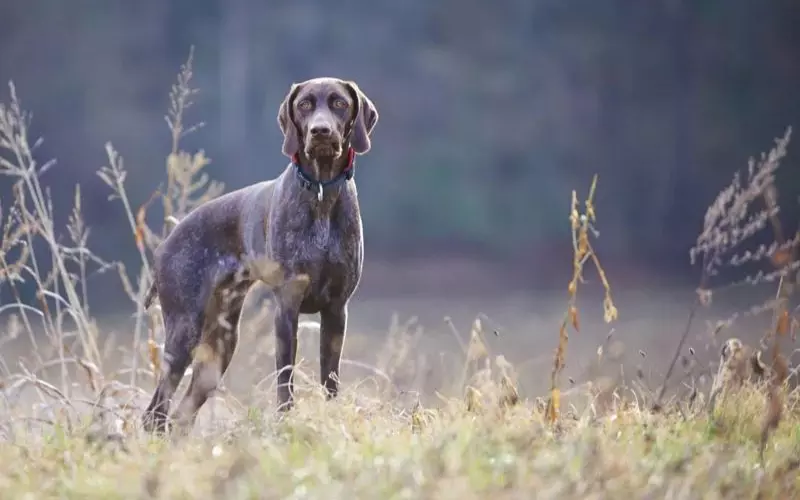
The German Shorthaired Pointer is a fascinating animal with an interesting life cycle. Like other mammals, their life cycle begins with the process of reproduction. Reproduction in German Shorthaired Pointers involves a male and a female coming together to create new life. The male dog has particular organs called testicles that produce small sperm cells. These sperm are needed to fertilize the female’s eggs. The female dog has particular organs called ovaries that produce eggs. When the female is ready to mate, she releases a scent that attracts male dogs. The male dog will then mate with the female, and the sperm from the male will meet the eggs from the female, leading to fertilization.
Once the female German Shorthaired Pointer is fertilized, she will carry the unborn puppies in her womb. This period is called pregnancy. The pregnancy in German Shorthaired Pointers lasts for about 63 days. The female dog will show physical changes during this time, such as a growing belly. Finally, when the puppies are fully developed, the female dog will go through the birth process. This is called labour. Labour can be a long and painful process for the female dog, but the puppies must enter the world and start their life cycle.
After the puppies are born, they enter the next stage of their life cycle. They are entirely dependent on their mother for nourishment and care. As they grow, they will start to explore their surroundings and learn essential skills from their mother, such as hunting and socializing. This stage is crucial for their development into healthy and happy German Shorthaired Pointers. As they grow, they will eventually reach adulthood, be ready to mate and continue the life cycle.
Threats to German Shorthaired Pointer
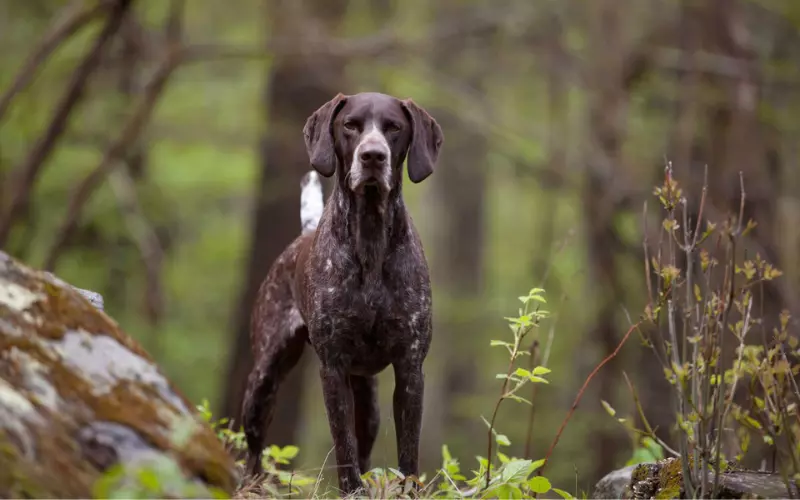
The German Shorthaired Pointer animal faces various threats that can harm its well-being. One major threat is habitat loss. Due to human activities such as deforestation and urbanization, these animals’ natural habitats are being destroyed. This affects the German Shorthaired Pointer and other wildlife that depend on those habitats for survival. When their homes are destroyed, these animals struggle to find food, water, and shelter, which can lead to a decline in their population.
Another threat to the German Shorthaired Pointer is poaching and illegal wildlife trade. Some people capture and sell these animals as pets or for their body parts. This disrupts their natural way of life and contributes to their declining population. It is crucial to understand that these animals play an essential role in maintaining the balance of ecosystems, and their removal can harm the environment.
Furthermore, the German Shorthaired Pointer is also vulnerable to pollution and climate change. Pollution from industries and vehicles can contaminate their habitats, making it difficult for them to survive. Additionally, climate change can alter their natural environment, affecting their ability to find food and mates. Extreme weather events like heat waves or hurricanes can also significantly threaten their well-being.
Raising awareness about these threats is essential to protect the German Shorthaired Pointer and ensure its survival. Conservation efforts such as creating protected areas, enforcing strict laws against poaching and illegal trade, and reducing pollution can greatly contribute to their preservation. We must work together to safeguard the German Shorthaired Pointer and other endangered animals, as they play a crucial role in maintaining the diversity and balance of our ecosystems.
Population of German Shorthaired Pointer

The German Shorthaired Pointer animal population is estimated to be around 100,000 worldwide. Many people love these dogs for their intelligence, agility, and friendly nature. They are often trained to be hunting companions, as they have a keen sense of smell and are excellent at retrieving. However, their numbers have decreased in recent years due to several factors, such as habitat loss and illegal hunting.
No more animals will be left if the German Shorthaired Pointer becomes extinct. Extinction happens when a species can no longer survive in its natural habitat, often due to human activities like deforestation or pollution. Sadly, many animals have gone extinct throughout history, a significant loss to our planet. We need to take care of our environment and protect the habitats of these beautiful creatures so that they can thrive and continue to be a part of our world.
To prevent the extinction of animals like the German Shorthaired Pointer, we must raise awareness about the importance of conservation and the need to protect our natural resources. This includes preserving and restoring their habitats, enforcing laws against wildlife poaching, and promoting responsible pet ownership. By taking these actions, we can help ensure that future generations can enjoy the presence of these magnificent animals in our world.
Conclusion
The German Shorthaired Pointer has a rich history as a versatile hunting dog. It originated in Germany and was bred to be a multi-purpose hunting companion. These dogs are known for their intelligence, agility, and endurance, making them excellent at locating and retrieving games. They have a short coat with a distinctive pattern of liver or black spots, making them easily recognizable.
In terms of size, the German Shorthaired Pointer is a medium to large breed. They typically weigh 55 to 70 pounds and stand about 21 to 25 inches tall at the shoulder. Due to their strong hunting instincts and energetic nature, these dogs require regular exercise and mental stimulation to keep them happy and healthy.
Regarding habitat, German Shorthaired Pointers are adaptable and thrive in various environments. However, they do best in homes with active owners who can provide them with plenty of exercise and attention. Whether it’s a large backyard or a home near a park, these dogs enjoy having space to run and explore.
In terms of classification, the German Shorthaired Pointer is a member of the sporting group according to the American Kennel Club. This group includes breeds that are bred for hunting and other sporting activities. Unsurprisingly, this breed excels in the field due to their natural hunting abilities.
The German Shorthaired Pointer is a fascinating animal with a rich history and exciting characteristics. Its versatility, intelligence, and endurance make it an ideal companion for active individuals or families who enjoy outdoor activities. As a medium to large-sized breed, these dogs require regular exercise and mental stimulation to thrive. They adapt to various environments but do best in homes with ample space to explore. The German Shorthaired Pointer’s classification as a member of the sporting group showcases their natural hunting instincts and abilities.
Frequently Asked Questions about German Shorthaired Pointer (FAQ’s)
What is a German Shorthaired Pointer?
A German Shorthaired Pointer is a hunting dog known for versatility and athleticism.
Where did German Shorthaired Pointers originate from?
German Shorthaired Pointers originated in Germany in the 19th century.
What is the average size of a German Shorthaired Pointer?
The average height of a German Shorthaired Pointer is between 21 and 25 inches, and they weigh between 45 and 70 pounds.
Are German Shorthaired Pointers good with children?
Yes, German Shorthaired Pointers are generally good with children and can be affectionate and protective.
Do German Shorthaired Pointers require a lot of exercise?
Yes, German Shorthaired Pointers are an active breed that requires regular exercise to stay happy and healthy.
Are German Shorthaired Pointers easy to train?
Yes, German Shorthaired Pointers are intelligent and trainable, making them suitable for various activities such as obedience, agility, and hunting.
Do German Shorthaired Pointers get along well with other dogs?
German Shorthaired Pointers can get along with other dogs if properly socialized and introduced.
Are German Shorthaired Pointers good watchdogs?
Yes, German Shorthaired Pointers have a protective instinct and can make good watchdogs.
Do German Shorthaired Pointers shed a lot?
Yes, German Shorthaired Pointers have a short, dense coat that sheds moderately year-round.
Can German Shorthaired Pointers be left alone for long periods?
No, German Shorthaired Pointers are highly social dogs and may become anxious or develop destructive behaviour if left alone for extended periods.
Are German Shorthaired Pointers prone to any health issues?
German Shorthaired Pointers can be prone to specific health issues such as hip dysplasia, bloat, and eye diseases.
Are German Shorthaired Pointers suitable for apartment living?
German Shorthaired Pointers are not generally recommended for apartment living, as they require a lot of space and exercise.
Do German Shorthaired Pointers make good family pets?
Yes, German Shorthaired Pointers can make excellent family pets, particularly for active households.
How long do German Shorthaired Pointers typically live?
The average lifespan of a German Shorthaired Pointer is between 12 to 14 years.
Can German Shorthaired Pointers be aggressive?
German Shorthaired Pointers are not known to be aggressive by nature, but like any dog breed, individual temperament may vary depending on their upbringing and socialization.

Hi there! I’m Morgan Gutierrez, and I love animals! I work as a Seasonal Animal Care Specialist at Brookfield Zoo and also teach people about animals, which is super fun. I studied at Valparaiso University in Lockport, Illinois, where I learned even more about these amazing creatures.
I’m not just about taking care of animals; I write articles about them, too! I explore and share many interesting animal stories, from cute kittens to giant elephants.
In the past, I’ve worked with veterinarians, helped with research, and even been an Animal Ambassador, bringing animals closer to people. Animals are my passion, and I enjoy helping others learn about them. So, if you ever want to know about animals, feel free to ask. I’ll explain it in a way that’s easy to understand, just like talking to a friend!












